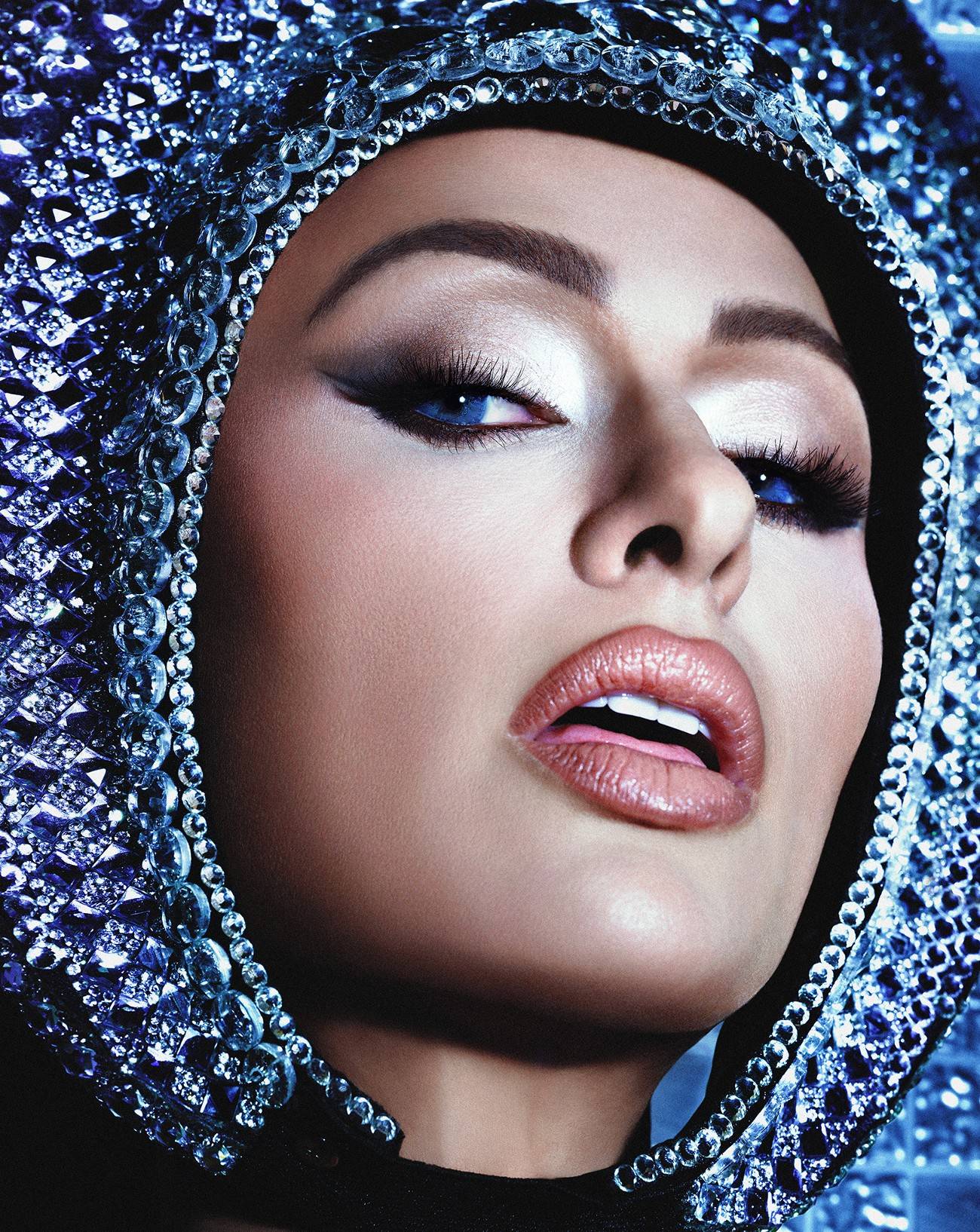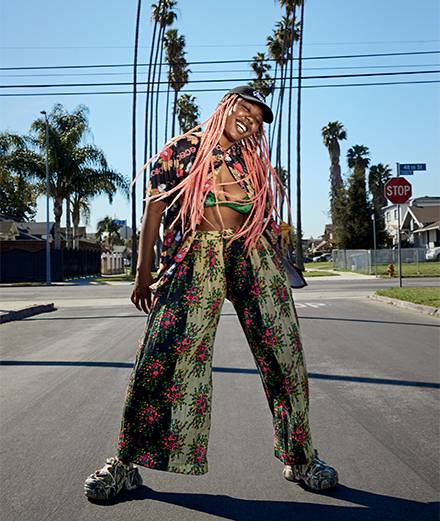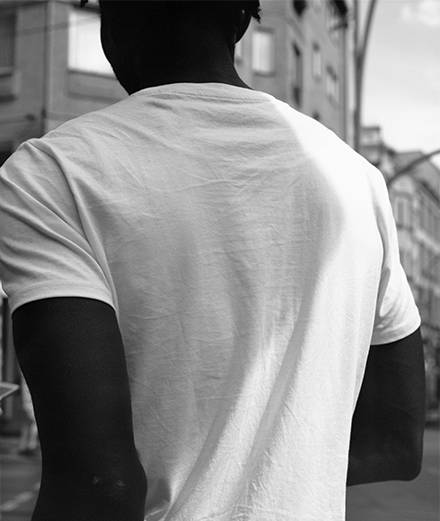

NUMÉRO: Like me, you’ve been working with Numéro since the magazine’s launch, over 20 years ago. How on earth have we managed to hang on so long?
JEAN-BAPTISTE: Well isn’t that a nice way to start the interview? Listen, we’ve absolutely nothing to complain about, we’re talking about Numéro after all. There’s a real sort of resistance to this magazine, which, moreover, unites in one cover all the ingredients I like.
What exactly do you mean by “resistance”?
A real resistance with respect to an era that worships at the altar of celebrity. Numéro has remained a fashion magazine in the noble sense of the term, and has kept fashion as its central concern.
How did you meet our delicious editor-in-chief, Babeth Djian?
I met her in the 1980s, at a time when we worked together on many shoots for magazines such as The Face, Glamour, American Woman, etc. I didn’t get the chance, alas, to work with her on her magazine Jil, but she was part of a group of young creative fashion editors who mattered, alongside Carine Roitfeld.
How have women’s magazines changed since then?
Things change, the world moves on and the main quality of fashion is to constantly be evolving so as to both reflect and anticipate the Zeitgeist.
So where did you actually meet Babeth for the first time?
I don’t remember, I’m too old.
You never slept together?
No. I guess I’m not her type.
“I’ve always felt a sort of dissatisfaction – or curiosity perhaps – that pushes me to widen my horizons, to see what it’s like elsewhere.”
How the devil did you manage not to be undone by the #MeToo movement, which has put an end to so many other famous photographers’ careers?
I don’t use my camera as an extension of my penis.
What was it like growing up in the disadvantaged 93 banlieue?
When you grow up somewhere, you don’t know what it’s like elsewhere, so you don’t fantasize about things you don’t know. I’ve always found wherever I was living interesting, but at the same time I was never satisfied with where I lived, no more today than when I was in my housing estate in the 93. I’ve always felt a sort of dissatisfaction – or curiosity perhaps – that pushes me to widen my horizons, to see what it’s like elsewhere. And I’m not at all nostalgic – I’d be incapable of telling you, for example, that there were periods of my life that were better or worse than others, not even when I went bald, which is saying something.
I noticed that you’ve very rarely taken part in exhibitions during your career…
I never did so until Babeth asked me to show my work for Numéro at the Studio des Acacias.
What about your 2012 exhibition of photos of cows at the Milk gallery? That counts for nothing?
Thank you for reminding me of it! It was a series of photos I’d done for Philippe Starck for the Hudson Hotel in New York, right in the middle of the mad-cow crisis. Which is where the idea came from to photograph bovines coiffed with rather large couture hats. Especially since I knew I wouldn’t have any personal copyright issues with cows, so I could exhibit them as I saw fit.


At what age did you start getting interested in photography?
Never.
What do you mean, “never”?
Photography never interested me.
So why on earth did you become a photographer?
Images are what interest me, not photos – it’s not quite the same thing. What’s more, I still don’t own a camera. The medium is of little importance – be it a pencil and paper, a stills camera or a video camera, it’s all the same to me. What counts is the final image.
Do you remember the first image that struck you?
Yes, it was almost certainly a Christ on the cross.
Sorry, what did you say, Christian Lacroix?
Oh help, I say “Christ on the cross” and he hears “Christian Lacroix.” Who I like a lot by the way, but clearly I’m dealing with a screaming fashion queen here, this isn’t going to be easy. When I was a child, my mother had the very good idea of signing me up for the choir in the local church in Aubervilliers. To give you a bit of background, I was born in 1949, after the war, to a family of Italian immigrants. In my childhood there were no newspapers, TV, images, statues – the world I lived in was grey, sepia and black. There were no representations of the human body, no nudity, everybody was covered up. So when my mother took me to church, it was the equivalent of taking me to see an exhibition of work by Jeff Koons – the colour, the smells, the incense, the statues, the sensuality, the ecstasy, the beauty…
“Images are what interest me, not photos – it’s not quite the same thing.”
…the priests on the lookout for young flesh…
I never had any problems where that was concerned, thank god. For me the church was a realm of fantasy: there were bodies, curves, muscles, blood, etc. and it was the first time I was confronted with such sensuality. Icons I discovered later – the album covers of Jimi Hendrix or Elvis Presley – produced exactly the same effect on me. Anyway, at the age of 20 I left Aubervilliers on a pilgrimage to the Isle of Wight to hear Hendrix in concert. And I never came back – I stayed in London where I learned English working in nightclubs.
And what was your job in these nightclubs? Bouncer?
I had the violence but not the physical bulk for a doorman, so I ended up in the cloakroom of a club run by a group of French people called La Poubelle. Then I worked as a barman and afterwards ended up as the DJ. The term “DJ” didn’t exist at the time, I was known as the “disquaire.” What’s more we shouldn’t forget that it was the French who invented the disco; the English swore only by their pubs and live music. Anyway, in London I learned a new language, and I learned how to use it – because in the 93 things were pretty miserable back then…
“When my mother took me to church, it was the equivalent of taking me to see an exhibition of work by Jeff Koons – the colour, the smells, the incense, the statues, the sensuality, the ecstasy, the beauty…”
How did sexuality express itself in the pre-AIDS 70s?
I was 20, horny as hell, and hadn’t been taught about any of that during my childhood. So you can imagine. A lot of wanking to start with, then a few English girlfriends, then sex, the female body, trying out drugs, music… When I finally returned to Aubervilliers, exhausted – because while all of that is character building it also takes its toll physically – my childhood friends didn’t recognize me, and nor did I.
What did your parents do?
My mother was a cleaner and my father – who moved with her to France during the reconstruction after World War I – was a mason and later a stevedore. In spite of myself, I went further than my father very quickly: at 20 I played guitar, spoke English, wore an earring, lived in London… The poor guy didn’t know what to think, and was very worried about me.
I remember being astonished by an ad you directed for the launch of the Jean Paul Gaultier perfume in 1995… What gave you the idea of using morphing, a type of technology which was very rarely employed at that time?
Wait a minute, we’ve jumped miles and miles ahead here, I was still talking about when I got back to France from London…


Who said we were doing this chronologically?
Clearly we’re not. Thanks for letting me know! To answer your question, let’s get things straight: when I started out as a photographer, it was a completely different profession. When I came back from London, a friend got me into the advertising and PR company Publicis as an intern, at a time when interns were paid because it wasn’t considered the done thing to exploit adolescents. They got me to design and prepare the layouts for printed adverts, and it was there that I first saw photographers’ portfolios. I didn’t have any experience, but at least I could speak English. I still played guitar and I used to hang out with rock groups, a number of whom – [Alain] Bashung, Telephone, the whole French rock scene – were just starting to get contracts with record companies. So I said to them, “Let me do your album covers because no one else is doing it in France.” Whereas in England it was established practice.
“I felt – and I still do – a certain tenderness for women who are a bit rock chick and androgynous, which photographers who preceded me didn’t seem to feel, however good their work was.”
So I started to look for photographers to work with, until the day I finally decided to do the photos myself. That’s how I got into the saddle. When I started out, I had zero knowledge of the history of photography: I’d never heard of Richard Avedon or Irving Penn. Which perhaps wasn’t such a bad thing to the extent that it can be rather paralyzing to see others’ work – sometimes it’s better to use your instinct without knowing it. I remember that I had a hang-up about my origins, since I came from the 93 and everyone else at Publicis had gone to [the graphic-art school] Penninghen. England had shaped me differently. Whenever an English illustrator or photographer came over to show their portfolio, they always asked me to be present because I spoke perfect Cockney whereas they all stuttered away in bad Franglais. Anyway, long story short, the photographers at the time – Avedon, Penn, Guy Bourdin, David Bailey – all had their own studios and labs where they developed their own rolls of film and made their own prints. Which wasn’t at all my case. So I started out using a Polaroid – they’d just launched the SX-70 – which was a miracle, and which allowed me to train my eye in the same way people today do so with their iPhone and Instagram. I started to have a bit of success because the way I saw women was not as a girl in a harness or a little redhead with blusher and fuzzy hair…
Well that’s Helmut Newton and Guy Bourdin taken care of…
Two giant photographers whose work I wasn’t so familiar with. For me, a girl of my generation was more likely to have short hair or to shave her head, because I hung out with punks in London and with the whole gang at the Palace in Paris and saw what the generation to come would be like. I felt – and I still do – a certain tenderness for women who are a bit rock chick and androgynous, which photographers who preceded me didn’t seem to feel, however good their work was. I was fresh – youth has that strength, it takes what’s been done and regurgitates it naively but with passion. Afterwards, I was lucky enough to work for studios that had been opened by the press, one of the first being [Daniel] Filipacchi’s in the Rue des Acacias funnily enough.
“My ideas are above all linked to people far more than to technology.”
You’re rambling, it’s awful! Let’s get back to the Jean Paul Gaultier ad if you don’t mind.
I was just getting there. While certain publications – Façade, which was the magazine of Le Palace, i-D, The Face, Actuel, etc. – allowed me to develop my photography, and certain TV stations – M6 and MTV in particular – gave me the chance to experiment with film, it was advertising that taught me art direction. For years, couture houses like Patou or Yves Saint Laurent would only bring out a perfume every ten years. With Calvin Klein came the explosion – just by selling a few pairs of men’s briefs he managed to revolutionize the perfume industry, and the old model went up in smoke. All of a sudden perfume was democratized in a way it hadn’t been before. I knew Jean Paul, of course, I’d done photos for him, and we were given extraordinary freedom when we made that ad. The perfume had been entirely designed – scent, bottle, packaging, art direction – by Jean Paul himself. Everyone was worried about the launch, except him and me. And they were all wrong, the perfume was extremely successful.
How did you develop the technical side of things for the sumptuous video you shot for Boy George’s single To Be Reborn in 1987?
I’d already had the idea. And my ideas are above all linked to people far more than to technology, which is only ever there to reinforce the message you’re trying to get across. It so happened that at that moment in time Boy George wasn’t doing so well. And when he asked me to work with him on this track, I immediately said to myself that he needed tactfulness and tenderness. That’s why I decided to have a little girl’s hand tenderly turning the pages of a photo album as well as the leaves of tracing paper separating each page… I wanted to bring in a certain purity at a point in time when the press were attacking him as a drugged-out washed-up old fag. I wanted to bring him redemption. For To Be Reborn, I asked people in Paris who were experimenting with 3D to superimpose shots of him singing onto blue pages. Since you also needed to take into account the play of transparency of the tracing paper, it certainly wasn’t easy, but the result, for the time, was exceptional. Where technology is concerned, I’ve always wanted to move forward, to move things forward, both through curiosity and gourmandise. Where people stop, I get bored. And everything that stops me – success, recognition, praise, exhibitions – leaves me perplexed as to what to do about it.
And was Madonna nice or not?
[Laughs.] What an old-hairdresser question! Are you nice at work? It’s not what I’ve been told. Do we really need to know if people who do interesting stuff are nice? Why the hell should you care? Are you planning a cruise to Corsica with her? Somehow I doubt it.
“Where technology is concerned, I’ve always wanted to move forward, to move things forward, both through curiosity and gourmandise. Where people stop, I get bored.”
Once and for all, can you tell us why Madonna runs away with the kid at the end of the video you shot for Open Your Heart in 1986?
It was another example of redemption, a theme that’s closely linked to my Catholic upbringing and which comes back time and again in my work. At the end of all my projects I adore – j’adore like in Dior’s films – giving the impression of a way out, an escape, a salvation. It’s also because personally I always look to run away and not get myself caught.
The video is amazing – where did you shoot it?
In Los Angeles. It took two days. At the time, artists and record companies – and me too, of course – were all very excited to be able to shoot a video for MTV, and to get close to the magic of the movies. That isn’t really the case anymore today.
Who was the most odious editor you ever worked with?
The odious ones don’t last, so I don’t remember. But I think you’d better watch out!








